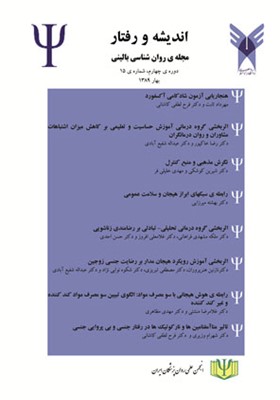پایش نقش درونگرایی، ناگویی خلقی و تکانشگری در اختلال وسواس فکری- عملی
محورهای موضوعی :محمد مهتری آرانی 1 , فرشته راشد 2
1 - استادیار گروه مدیریت مالی، دانشگاه پیام نور، ایران
2 - دپارتمان مشاوره خانواده، دانشگاه شهید بهشتی، تهران، ایران
کلید واژه: وسواس فکری- عملی, تکانشگری, ناگویی خلقی, درونگرایی,
چکیده مقاله :
اختلال وسواس فکری- عملی شامل گروهی از اختلالات روانی است که مهمترین ویژگیهای آنها افکار و اندیشههای غیرنیتمندانه، مخل ذهن و نیز کردارها و رفتارهای آزاربخش، مکرر و مبتنی بر اعمال مناسک گونهای است که در راستای دوری گزینی از اضطراب و یا نفی افکار و اندیشههای وسواس گونه شکلگرفته و در تنزل کیفیت زندگی و ایجاد اختلال در عملکردهای اجتماعی و شغلی نقش مخربی دارد. هدف از این پژوهش، پایش نقش درونگرایی، ناگویی خلقی و تکانشگری در اختلال وسواس فکری- عملی بود. برای این منظور طی یک پژوهش پیمایشی 230 نفر از شهروندان شهر بادرود بر اساس شیوه نمونهگیری در دسترس انتخاب و از نظر سواس فکری- عملی، تکانشگری، ناگویی خلقی و درونگرایی مورد ارزیابی قرار گرفتند. یافتههای نشان دادند که پاسخگویان گرایش خفیفی به اندیشهها و رفتارهای وسواسی داشتند. به لحاظ تکانشگری، اکثریت آزمودنیها از تکانش گری پایینی برخوردار بوده و توانایی آنها در تشخیص و ابراز هیجان، همدردی و کنترل در حد متوسط بود. 6/6 درصد آزمودنیها درونگرا بودند. تحلیل یافتهها نشان داد که تکانشگری، درونگرایی و ناگویی خلقی تاثیری مستقیم و مثبت بر اختلال وسواس فکری/ عملی دارد. همچنین، بیشترین اثرگذاری کلی شاخصها بر OCD مربوط به متغیر درونگرایی و سپس تکانشگری بود.
Obsessive-compulsive disorder compromises a group of mental disorders manifesting themselves with important features such as involuntary and mind-disturbing thoughts; harassing, recurring, and stereotypical actions and behaviors which have been all formed in line of avoiding anxiety or negating obsessive thoughts that do establish a destructive role in degrading the quality of life and disrupting one’s social and occupational functions. This present research is to investigate role of introversion, alexithymia, and impulsiveness in the obsessive-compulsive disorder. For this purpose, a survey on 230 citizens of Badrood city was conducted based on the sampling method available in which their introversion, alexithymia, and impulsiveness in the obsessive-compulsive disorder were thoroughly covered. The findings demonstrated that the respondent tended mildly towards obsessive thoughts and behaviours. As far as impulsiveness was concerned, majority of the citizens revealed low impulsivity and their ability in recognizing and expressing emotions; and sympathizing and restring the situation appeared to be moderate. 6.6% of the cases were totally introverted. Based on the findings gained, it was confirmed that impulsivity, introversion, and alexithymia influenced directly and positively the obsessive-compulsive disorder. Also, the most prevalent effect of the indices on the OCD was pertained to the inversion and impulsivity variables, respectively


